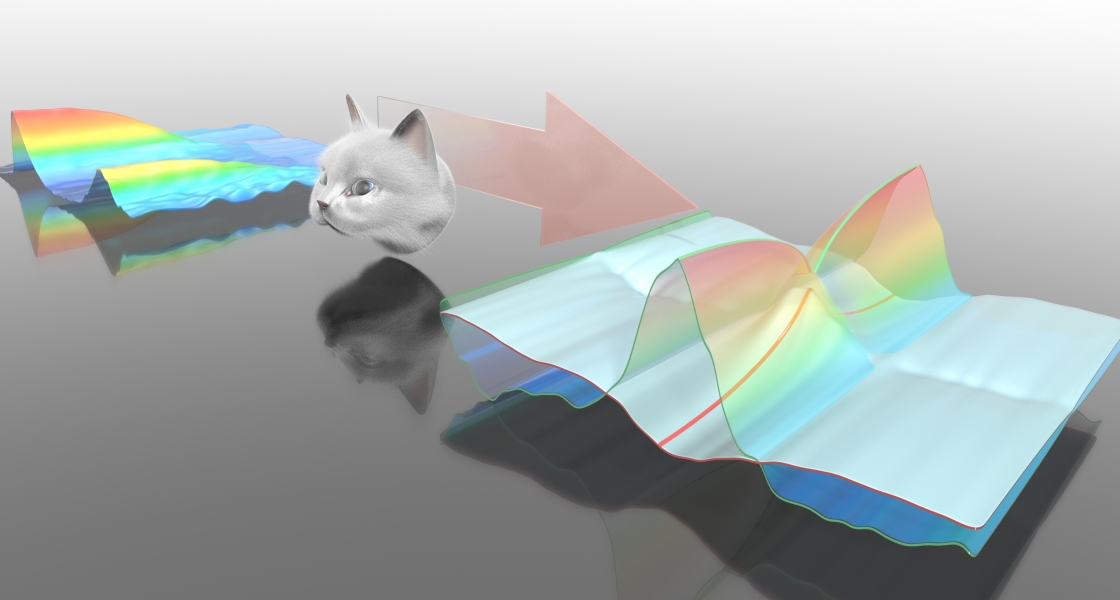We can get valuable information about a material by studying how it responds to light. But up to now, researchers have been forced to ignore how some of light’s stranger quantum behavior, such as being in a superposition of one or more intensity states, affects these measurements. New research from the Cundiff group (with newly minted PhD Ryan Smith and graduate student Andy Hunter) has shown that it is possible to back-calculate how a semiconductor responds to light’s quantum features even though we can’t directly create light with those features. This work was built upon theory developed by collaborators at the University of Marburg in Germany. The resulting new method of “quantum spectroscopy” opens the door to a deeper understanding of semiconductor properties.
Spectroscopy is a time-tested method for investigating the properties of materials such as semiconductors. Researchers shine a laser on a sample and see what happens. They infer information about the material from these observations. This process is similar to deducing information about a piece of window glass by looking at the transmitted sunlight on the other side.
In the laboratory, scientists can vary aspects of the probe laser, such as its color and intensity or how long it shines on the sample. But there is more to light than these familiar wave-like properties. A beam of light can also be seen as a stream of particles called photons, which have hidden – and often strange – quantum mechanical properties. For instance, we do not yet have the technological capability look inside light and see superpositions of different intensities. And accurate theoretical predictions are challenging in complicated systems like semiconductors. Consequently, researchers have remained in the dark about how these properties of light might affect spectroscopy experiments.
To illuminate the effects of light’s quantum features, Cundiff and his colleagues have been working on developing a new type of spectroscopy. Since they can’t tune a laser to emit light with particular quantum properties, they instead measure a sample’s response as the light intensity from a typical laser is varied. Using this information and theory developed by the group at Marburg University, they back-calculate how the system would respond if they had manipulated the quantum nature of the light in what is called a Schrödinger Cat state (Figure 1).
This technique works because light in a Schrödinger Cat state can be mathematically reconstructed by adding together two different intensities of normal laser light. But, here’s where the quantum weirdness comes in: If we could make a detector that could measure the intensity of Schrödinger Cat light, it either would measure one of two intensities or the other, but not something in between. Like the mythical cat of the same name (which is simultaneously both ‘alive’ and ‘dead’ until you open the box), Schrödinger Cat light has two intensities simultaneously. Even though they can’t yet make such light in the lab, the Cundiff team was able reconstruct the effects of Schrödinger Cat light on the sample by adding together the effects of the regular laser light intensities that make up cat light.
Naturally, the response of a material to light’s quantum behavior isn’t straightforward: it only shows up as higher-order “wiggles” in the material’s absorption that are only visible when the light is intense enough. It’s like hitting a piano key hard. If you bang on the key, you not only hear that note, but also several other higher tones set off by the hammer. These overtones are called higher harmonics.
The Cundiff group “listened” for those higher harmonics in the absorption of the semiconductor. To see them, the researchers hit a sample of a gallium-arsenide (GaAs) semiconductor with laser pulses of varying high intensities and correlated the laser intensity with resulting changes in the sample’s absorption of a probe laser pulse.
“That’s not particularly new,” said Cundiff. “People have been doing this forever.” “The key thing that we did is that we did it carefully.” Adding together the results of careful measurements allowed the researchers to then reconstruct the response of the sample to Schrödinger Cat light.
This work is particularly exciting because it shows that light’s quantum features are important in how a material responds to light. And, the methods suggest a way to apply this quantum-optical spectroscopy in a variety of complex materials. The understanding gained from these experiments could lead to customized optoelectronics devices such as semiconductor lasers. -- Stephanie Chasteen



 The Physics Frontiers Centers (PFC) program supports university-based centers and institutes where the collective efforts of a larger group of individuals can enable transformational advances in the most promising research areas. The program is designed to foster major breakthroughs at the intellectual frontiers of physics by providing needed resources such as combinations of talents, skills, disciplines, and/or specialized infrastructure, not usually available to individual investigators or small groups, in an environment in which the collective efforts of the larger group can be shown to be seminal to promoting significant progress in the science and the education of students. PFCs also include creative, substantive activities aimed at enhancing education, broadening participation of traditionally underrepresented groups, and outreach to the scientific community and general public.
The Physics Frontiers Centers (PFC) program supports university-based centers and institutes where the collective efforts of a larger group of individuals can enable transformational advances in the most promising research areas. The program is designed to foster major breakthroughs at the intellectual frontiers of physics by providing needed resources such as combinations of talents, skills, disciplines, and/or specialized infrastructure, not usually available to individual investigators or small groups, in an environment in which the collective efforts of the larger group can be shown to be seminal to promoting significant progress in the science and the education of students. PFCs also include creative, substantive activities aimed at enhancing education, broadening participation of traditionally underrepresented groups, and outreach to the scientific community and general public.